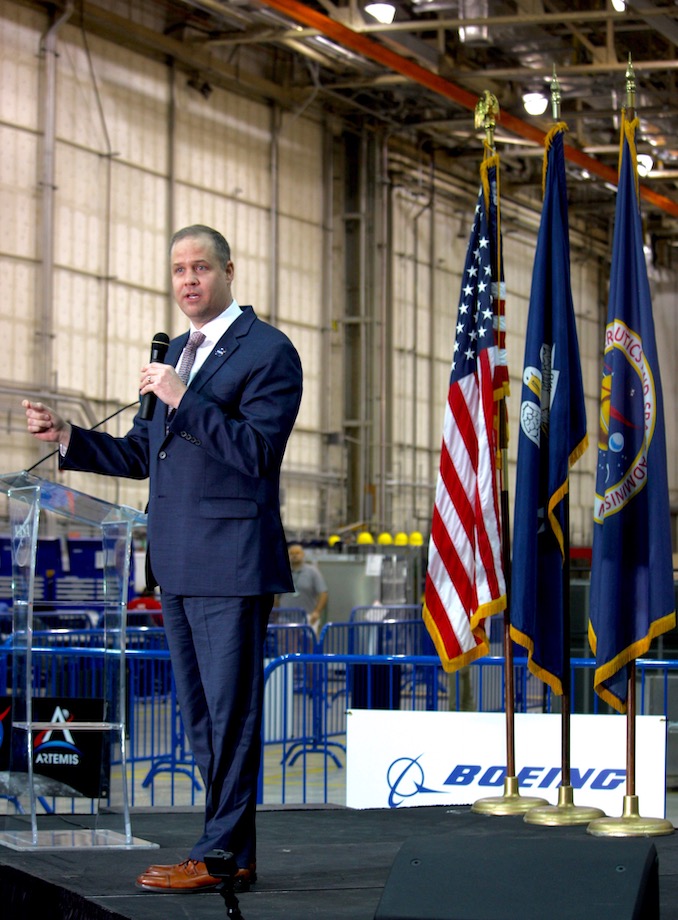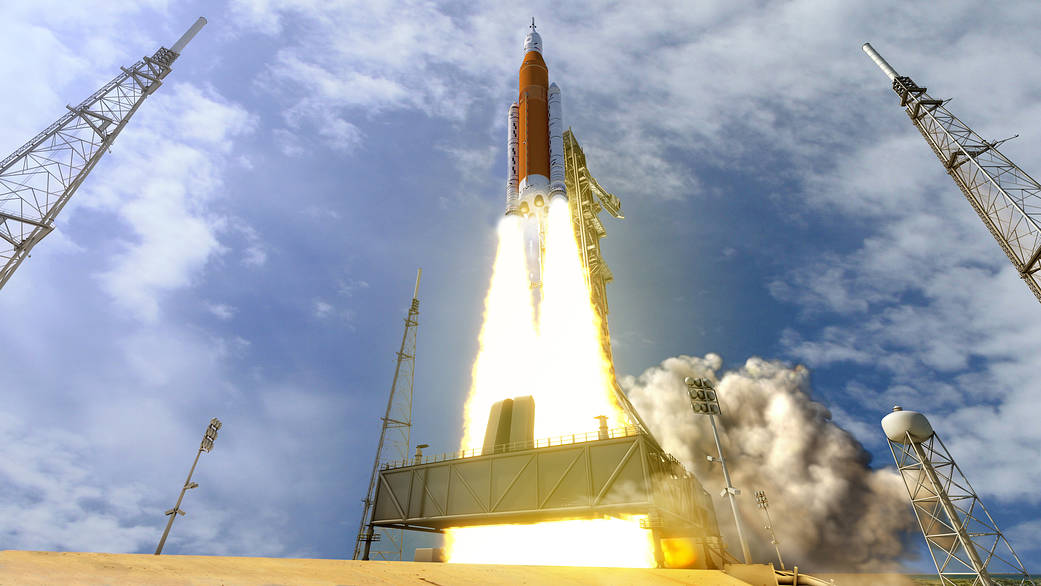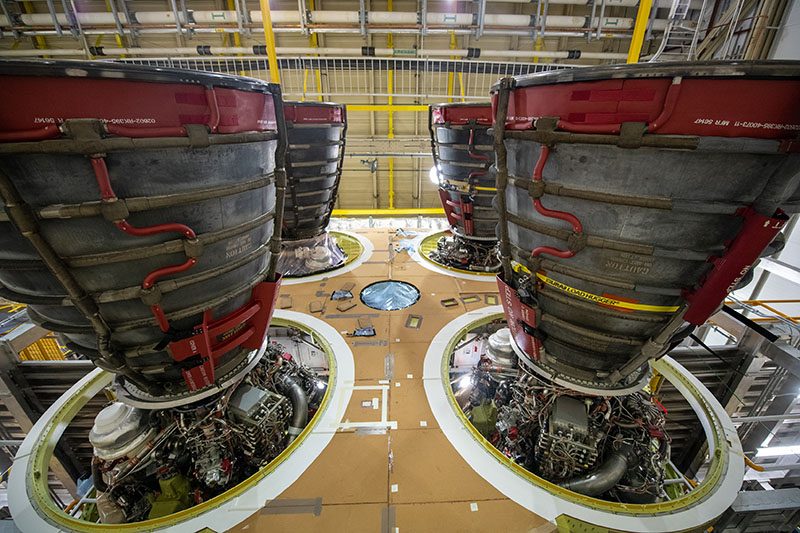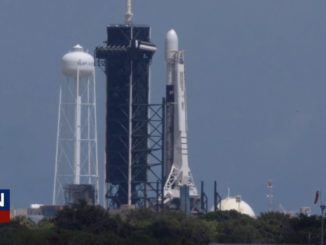
NASA has declared assembly complete on the core stage for the first Space Launch System heavy-lift rocket in New Orleans, signaling a long-awaited transition from manufacturing to testing as the core stage is set to move to the nearby Stennis Space Center in Mississippi for a hold-down firing next year of its four shuttle-era main engines.
The four RS-25 engines that will power the first SLS core stage have been installed on the rocket inside NASA’s Michoud Assembly Facility in Louisiana, and the 212-foot-long (65-meter), 27.6-foot-wide (8.4-meter) vehicle will soon be rolled out of the factory and transferred by barge to its next stop on the road to the launch pad at the Kennedy Space Center in Florida.
Once the stage — built by Boeing — arrives at the Stennis Space Center in Mississippi, teams will lift the rocket on the B-2 test stand, originally built to test the first stage of the Saturn 5 moon rocket, for a series of structural and modal testing, fueling rehearsals and an eight-minute firing of all four RS-25 engines — leftovers from the space shuttle program — to demonstrate the SLS core stage’s readiness for flight.
Then the rocket will be shipped to NASA’s Kennedy Space Center to begin final stacking with a pair of side-mounted solid rocket boosters, an upper stage, and an Orion crew capsule the SLS will launch on a trajectory toward the moon in 2021.
“Think of it as NASA’s Christmas present to America,” said NASA Administrator Jim Bridenstine in an event marking the SLS core stage completion Dec. 9. “We’re going to move it out of this facility. We’re going to take it to the Stennis Space Center. We’re going to do a ‘green run’ test. We’re going to prove its capability, we’re going to get it to the Cape, and we’re going to be ready to launch American astronauts to the moon again.”

NASA started working on the SLS program in 2011, following the cancellation of the Constellation moon program. The development timeline at that time called for the first launch of the SLS in 2017.
Since 2011, NASA has spent more than $15 billion on developing the Space Launch System.
In response to the most recent series of delays, which were primarily caused by issues with assembling the first core stage engine section, Boeing reconfigured the work flow inside the Michoud Assembly Facility, opting to connect the stage’s liquid hydrogen and liquid oxygen tanks before adding the engine section in a horizontal configuration inside the factory.
Technicians at Michoud finished installing the rocket’s four RS-25 engines in November. Since then, workers have commenced a series of functional tests before outfitting the core stage for the trip to Stennis.
Despite the recent progress, a target launch date for the first SLS launch remains uncertain. Since late 2017, NASA officials have announced delays of the first SLS flight from November 2018 — the NASA’s previous official launch commitment date for the first SLS mission — into 2019, 2020 and now 2021.
A more specific target SLS launch date, with schedule reserves, has not been announced by NASA.
The SLS is a centerpiece of the Artemis program, NASA’s initiative to return humans to the lunar surface by the end of 2024, a goal set earlier this year by Vice President Mike Pence. The Artemis 1 mission in 2021 will be an unpiloted test flight of the SLS and Orion spacecraft — designed to carry up to four astronauts into deep space — followed by a crewed mission around the moon in 2022.
The Artemis 3 mission, scheduled for 2024, would attempt the first lunar landing with astronauts since 1972, according to NASA’s current plans. In parallel with the SLS and Orion development efforts, NASA is developing a mini-space station called the Gateway in lunar orbit, and plans to partner with private industry to develop human-rated lunar landers. NASA aims to have all of the pieces ready within five years.

While Boeing teams in Louisiana have completed assembly of the first SLS core stage, Lockheed Martin engineers at the Kennedy Space Center have finished integrating the Orion spacecraft for the Artemis 1 mission. The Orion crew module, along with its European-built service module, flew from Florida to Ohio aboard a NASA transport plane last month to begin a series of environmental tests to subject the spacecraft to the extreme thermal and vacuum conditions it will encounter in deep space.
NASA Administrator Jim Bridenstine has named Doug Loverro, a veteran manager of U.S. military space programs, as the new head of the agency’s human exploration and operations directorate. Loverro joined NASA earlier this month, and one of his first tasks is establishing a new official launch schedule for the Artemis 1 mission.
“We have had the date out there that we would launch Artemis 1 in 2021,” Bridenstine said Dec. 9. “Of course, I want to make sure that, before I put a hard date on it, (we) give our new associate administrator time for him to do his own assessment, his own evaluation.”
Loverro said a new target launch schedule for Artemis 1 will be announced in the spring, likely some time after the White House releases its fiscal year 2021 budget request in the February timeframe.
John Shannon, Boeing’s vice president and general manager for the SLS program, said his team at Michoud has demonstrated improved performance since March, when Vice President Pence challenged NASA to achieve a human landing on the moon by the end of 2024. During the same speech, Pence said NASA should find industrial partners who can meet that deadline if the agency’s current industrial contractors cannot do so.
“I thought the Vice President’s comment was very fair, and I think it was very appropriate as well,” Shannon said. “The team took it as a challenge. This is hard.
“The first vehicle we built is a flight vehicle,” he said. “We didn’t get any prototypes, didn’t get any demonstration vehicles or anything like that. The first one you’ve got to get right. That takes extra time.”
Spaceflight Now members can read a transcript of our full interview with John Shannon. Become a member today and support our coverage.
Once the core stage rolls out of the Michoud factory — a milestone expected in late December or January — workers will load the rocket onto NASA’s Pegasus barge for the journey to Stennis.
After the core stage arrives at Stennis, teams will unload the rocket and lift it vertical for installation into the B-2 test stand, a massive structure modified to handle the SLS core stage.
One of the first tasks will be the connection of four liquid hydrogen feed lines between the core stage hydrogen tank and the engine section. Technicians will also hook up a hydrogen fill and drain valve used to load and unload fuel, according to Shannon.
The test campaign at Stennis is predicted to take several months, with the final exam — an eight-minute firing of all four engines — expected by mid-2020.
“The first thing we’ll do is what’s called a modal test,” Shannon said. “So we take this 27-and-a-half foot by 212-foot stage that’s unfueled, and we’ll suspend it over the exhaust hole on the stand, and we’ve got these big things — it’s not exactly right to call them hammers, but they’re essentially big hammers — that we ram the stage with so we can understand the resonant frequency of that core stage.
“We’ll flow that back into the models we have for how the vehicle will fly, and the guidance algorithms to make sure you’re not going to have some kind of a problem with the TVC (Thrust Vector Control) gimbal,” he said. “So after we finish that modal test, we’ll go hard down into the stand, and then we’ll go remove all the sensors from the outside of the vehicle that are used just for that modal test.”

Engineers will power up the SLS core stage on the B-2 test stand to exercise all of the rocket’s avionics, computers and other control systems.
“Then we’ll get into the avionics system power-up, and we’ll the power up all the flight computers and data systems, and all of the systems that control the various valves and wiring,” Shannon said in a recent interview with Spaceflight Now. “We also check out the development flight instrumentation hardware, so basically we do a full electrical power-up the entire system.
“Then we go into safing checks for the (propulsion) system. We exercise all the valves, we exercise the high-pressure helium system. We go through and make sure that for every sub-system on a rocket, we check it out and make sure it’s in good shape.”
Some time in the spring, engineers will perform a “wet dress rehearsal” on the core stage. During this practice run, the SLS core stage will be filled with some 730,000 gallons of super-cold liquid hydrogen and liquid oxygen propellants.
Shannon characterized the wet dress rehearsal as the “first big test” for the core stage.
“It’ll see cryo for the first time, and we will slowly do the chill of the vehicle by putting some cryo in, and we’ll look at our haz gas (hazard gas) sensors very closely (to check for leaks),” Shannon said. “We’ll look at the system response. We’ve got 700 different sensors on the vehicle we’re using during this test. And if that all looks good, we’ll go ahead and fill the entire vehicle up and sit there in stable replenish for some period of time, and then we’ll practice draining the vehicle.
“Then the Stennis facility will replenish their consumables, and about four or five days later, assuming that all the data review goes really well, we will re-fuel the vehicle with the intent of proceeding on for the eight-minute hotfire, and we will hotfire the vehicle,” he said. “Then we’ll safe it at end of it. We expect to drain the tanks doing that, the hydrogen tank anyway.”
The four RS-25 engines installed on the SLS core stage will go through a flight profile, throttling to different power settings as they would during a real launch. At maximum power, the engines will produce more than 2 million pounds of thrust.
On the Space Launch System, the RS-25 engines will operate at a 109 percent throttle setting during the first flight. During the space shuttle era, the engines were rated to operate at 104.5 percent during normal flight, and up to 109 percent in abort modes.
The RS-25 engines for the Space Launch System have been outfitted with new computers to regulate thrust and propellant mixture ratios in flight. And the engines on the SLS core stage have additional thermal shielding to protect them during launch. The SLS engines will see different thermal conditions than they experienced on the shuttle, when only three engines were mounted at the rear of the vehicle.
Unlike the engines that flew on the reusable space shuttle, the RS-25s on the Space Launch System will be jettisoned with the core stage and fall into the Atlantic Ocean, where they will not be recovered.
NASA has 16 shuttle main engines in its inventory to power four SLS missions through 2025. Aerojet Rocketdyne has a contract with NASA to manufacture new RS-25 engines, rated for even higher throttle settings, for additional SLS missions.

The four engines assigned to the Artemis 1 launch — and now installed on the core stage — helped power 21 space shuttle missions into orbit:
- Engine No. 2045: STS-89; STS-95; STS-92; STS-102; STS-105; STS-110; STS-113; STS-121; STS-118; STS-127; STS-131; STS-135
- Engine No. 2056: STS-104, STS-109, STS-114; STS-121
- Engine No. 2058: STS-116; STS-120; STS-124; STS-119; STS-129; STS-133
- Engine No. 2060: STS-127; STS-131; STS-135
After a review earlier this year, NASA officials opted to go ahead with the “green run” test at Stennis, rather than deliver the core stage directly from Michoud to the Kennedy Space Center, where engineers sketched out a plan to perform a shorter-duration hold-down firing on launch pad 39B.
Unlike full-stage firings of previous rockets, the green run test at Stennis will use the same core stage that will fly on the first SLS launch, and not a ground test article.
In the end, managers decided the full-duration test at Stennis would provide more data than a shorter-duration burn at Kennedy, giving engineers more confidence about the rocket’s readiness for flight.
“We’ve talked about how long is long enough to get enough information off the vehicle to really have that confidence to fly crew the second time (on the second SLS mission, Artemis 2), and we’ve kind of settled on it’s about 200 seconds to 230 seconds,” Shannon said.
He added that if a problem with the core stage itself forced a premature cutoff during the green run hotfire test, officials would likely want to fix the issue and repeat the test-firing. If a test stand malfunction caused an early shutdown, engineers could declare the test successful even if it does not achieve a full-duration firing.
“The one big thing that we really can’t analyze or simulate — we have to kind of see it in real-time — is if we’re running the engines and the liquid level in the hydrogen tank gets fairly low — like a third to half-full — we’re putting a lot of pressurization gas in it,” Shannon said. “Do you still have enough hydrogen coming off that lead to allow each of those hydraulic systems to do the fastest full gimbaling of the engines that’s possible?”
The gimbal actuators on the engines are used to steer the rocket in flight. After liftoff, hydrogen gas tapped off from the core stage pressurization system is used to drive the hydraulic system powering the engine gimbals.
“And our analysis says, yes, we’ve got almost four times the amount that we need for that, but don’t really know that,” Shannon said. “You need to go do the entire integrated test. So you’ll see that during during the test, at different times at different liquid levels, we’ll fairly aggressively gimbal the the engine nozzle in order to test that very question. Can you keep good pressure in the hydrogen tank while you’re while you’re aggressively gimbaling all four engines?”
There are two gimbal actuators on each engine, one in roll and on in pitch.
“We’ll move all of them in unison,” Shannon said. “It simulates booster separation, or if you had an engine out, or an issue like that, you really wouldn’t want to have a high demand on the gimbals that would affect the pressurization in the LH2 (liquid hydrogen) tank.
“I’m not that worried about it,” he said. “I think they’ve over-designed the system, and we’ve got a lot of margin there. But that’s probably one of the bigger things we’ll be testing while we do the green run test. That’s one of the reasons why the flight readiness firing idea, a short firing, wouldn’t answer that question. That was one of the main technical reasons why we decided let’s go do the full green run. This is our one chance to really understand the performance of the vehicle.”

After the green run hotfire, ground crews will inspect the core stage and repair any damage to the rocket’s orange spray-on foam insulation.
“We’ll prepare the vehicle to be shipped to the Cape,” Shannon said. “We’ll take it out of the hold-downs and rotate it onto the cradle and put it back on the Pegasus (barge) and head over to the Kennedy Space Center.”
Once at KSC, the core stage will be lifted atop NASA’s new mobile launch platform inside the Vehicle Assembly Building and lowered between two solid rocket boosters, which are derived from the side-mounted solid-fueled motors used by the space shuttle. An upper stage based on hardware flown on United Launch Alliance’s Delta 4-Heavy rocket will be hoisted on top, followed by installation of the Orion spacecraft for its trip around moon and back.
Email the author.
Follow Stephen Clark on Twitter: @StephenClark1.



